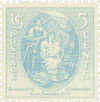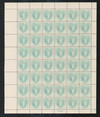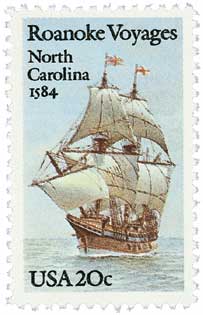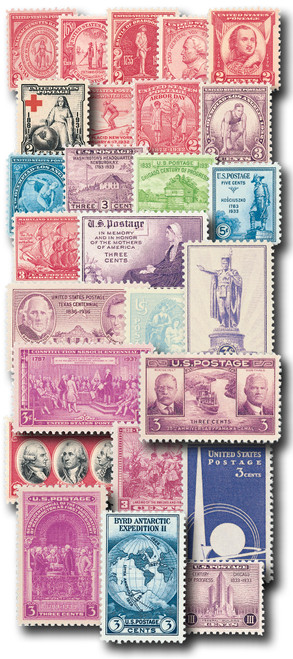
# 796 - 1937 5c Virginia Dare
U.S. #796
1937 5¢ Virginia Dare
Issue Date: August 18, 1937
First City: Manteo, NC
Quantity Issued: 25,040,400
First Of The Roanoke Voyages
Sir Walter Raleigh, who had quickly earned the favor of Queen Elizabeth I, funded the voyages. On March 25, 1584, the queen issued Raleigh a royal charter to “discover, search, find out, and view such remote heathen and barbarous Lands, Countries, and territories … to have, hold, occupy, and enjoy” in exchange for one-fifth of all the gold and silver mined there. The charter also stated that Raleigh must established a settlement within seven years or lose the right to do so.
Raleigh didn’t personally lead any of his expeditions, but he funded and authorized them. The first expedition, under the command of Philip Amada and Arthur Barlowe, departed England on April 27, 1584. Less than three months later it arrived on the coast of North Carolina on July 13. Upon their landing, they were the first people to wave the English flag above the New World’s shores.

The British colonists attempted to establish friendly relations with the Native Americans but were unsuccessful. They also didn’t have enough supplies to set up a permanent settlement, so they returned to England. Raleigh was then knighted for the expedition that claimed the land in the name of the queen.

A second voyage departed England in 1585. Its members returned in 1586 due to food shortages and hostile Indians. The third voyage brought 91 men, 17 women, and nine children to Roanoke Island in 1587. Their leader, John White, left the colony and returned to England to get badly needed supplies. He was unable to return for three years.

When White did return, on August 18, 1590, Virginia Dare’s third birthday, he discovered the colonists had deserted their settlement, which had been left in a shambles. No one has ever determined what happened to the colonists. Some historians believe the colonists may have joined American Indian tribes living in the region. The only clue as to the fate of the colonists was the word “CROATOAN” carved into the side of a large tree.
U.S. #796
1937 5¢ Virginia Dare
Issue Date: August 18, 1937
First City: Manteo, NC
Quantity Issued: 25,040,400
First Of The Roanoke Voyages
Sir Walter Raleigh, who had quickly earned the favor of Queen Elizabeth I, funded the voyages. On March 25, 1584, the queen issued Raleigh a royal charter to “discover, search, find out, and view such remote heathen and barbarous Lands, Countries, and territories … to have, hold, occupy, and enjoy” in exchange for one-fifth of all the gold and silver mined there. The charter also stated that Raleigh must established a settlement within seven years or lose the right to do so.
Raleigh didn’t personally lead any of his expeditions, but he funded and authorized them. The first expedition, under the command of Philip Amada and Arthur Barlowe, departed England on April 27, 1584. Less than three months later it arrived on the coast of North Carolina on July 13. Upon their landing, they were the first people to wave the English flag above the New World’s shores.

The British colonists attempted to establish friendly relations with the Native Americans but were unsuccessful. They also didn’t have enough supplies to set up a permanent settlement, so they returned to England. Raleigh was then knighted for the expedition that claimed the land in the name of the queen.

A second voyage departed England in 1585. Its members returned in 1586 due to food shortages and hostile Indians. The third voyage brought 91 men, 17 women, and nine children to Roanoke Island in 1587. Their leader, John White, left the colony and returned to England to get badly needed supplies. He was unable to return for three years.

When White did return, on August 18, 1590, Virginia Dare’s third birthday, he discovered the colonists had deserted their settlement, which had been left in a shambles. No one has ever determined what happened to the colonists. Some historians believe the colonists may have joined American Indian tribes living in the region. The only clue as to the fate of the colonists was the word “CROATOAN” carved into the side of a large tree.














